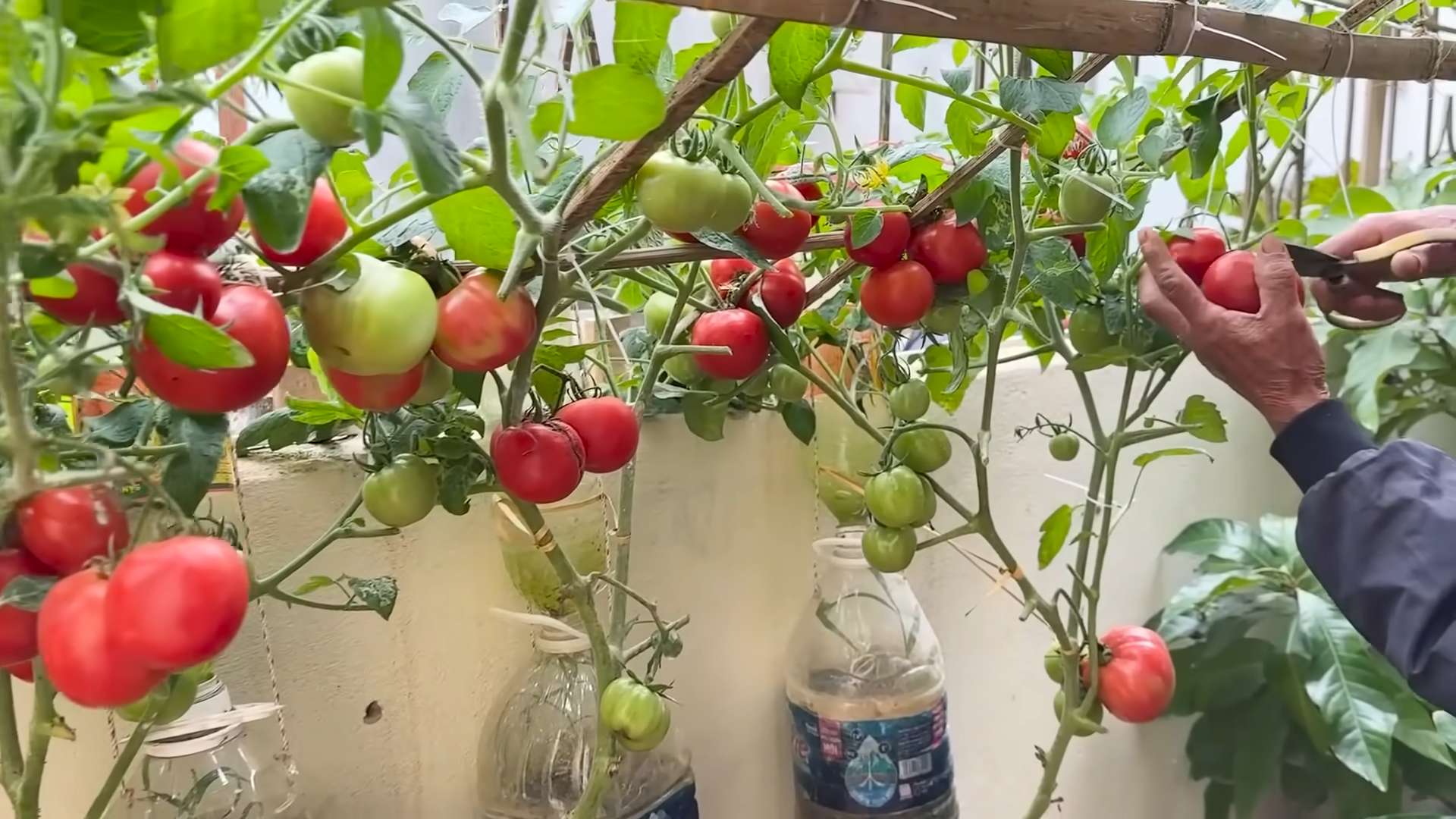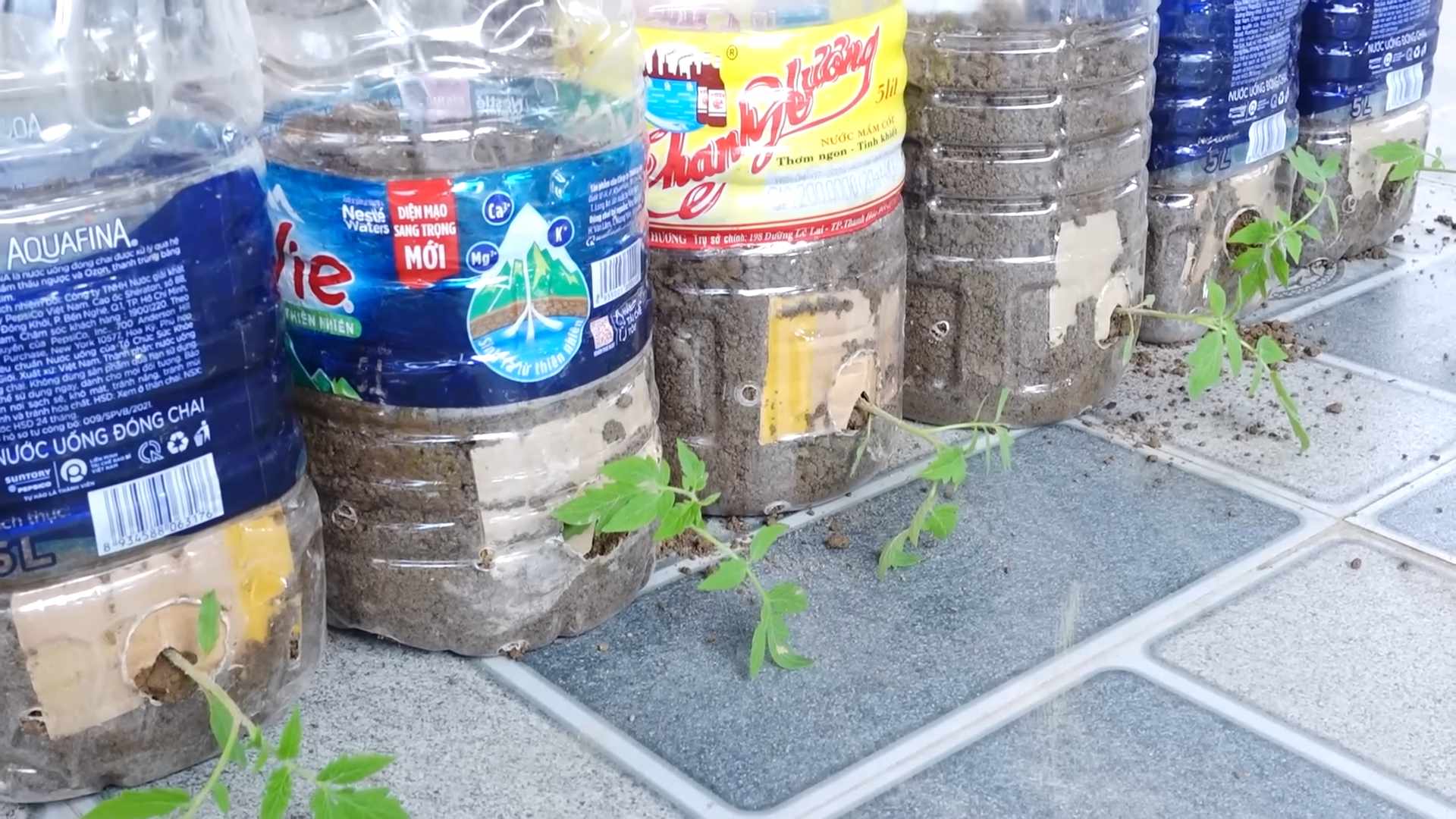Grow Tomatoes for Maximum Yield – isn’t that the dream of every home gardener? I know it’s mine! Imagine biting into a juicy, sun-ripened tomato, bursting with flavor, knowing you nurtured it from a tiny seed to a bountiful fruit. But let’s be honest, sometimes our tomato plants seem to have a mind of their own, producing fewer tomatoes than we hoped for, or worse, succumbing to pests and diseases.
The art of cultivating tomatoes stretches back centuries, with roots in South America where the wild ancestors of our modern varieties thrived. Indigenous cultures revered them, and their cultivation gradually spread across the globe. Today, tomatoes are a staple in cuisines worldwide, and the joy of growing your own is a connection to that rich history.
That’s why I’m so excited to share these DIY tricks and hacks to help you grow tomatoes for maximum yield! We’ll dive into simple, yet effective techniques that can transform your tomato patch from a struggling garden into a thriving oasis. From optimizing soil conditions to mastering pruning techniques, these tips will empower you to overcome common challenges and reap a harvest that will make your neighbors envious. Ready to unlock the secrets to tomato-growing success? Let’s get started!

Grow Tomatoes for Maximum Yield: My Foolproof Guide
Hey there, fellow tomato enthusiasts! I’m so excited to share my tried-and-true methods for growing tomatoes that practically explode with flavor and yield. I’ve spent years experimenting, tweaking, and learning from my mistakes (and successes!), and I’m confident that these tips will help you achieve a bumper crop of juicy, delicious tomatoes, no matter your experience level. Let’s get started!
Choosing the Right Tomato Variety
Before you even think about planting, it’s crucial to select the right tomato variety for your climate and preferences. There are literally hundreds to choose from, so don’t be overwhelmed! Here’s a breakdown to help you narrow it down:
* **Determinate vs. Indeterminate:** This is the big one!
* **Determinate tomatoes** grow to a specific size and produce all their fruit at once, making them ideal for canning or making sauce. They’re bushier and more compact. Think Roma or Celebrity.
* **Indeterminate tomatoes** keep growing and producing fruit throughout the season until frost hits. They require staking or caging and can get HUGE. Think Beefsteak, Cherry, or Heirloom varieties.
* **Days to Maturity:** This tells you how long it will take from planting to harvest. Choose varieties that fit your growing season. If you have a short summer, opt for early-maturing varieties.
* **Disease Resistance:** Look for varieties labeled with disease resistance codes (e.g., V, F, N, T, A). This can save you a lot of headaches later on.
* **Taste and Use:** Do you want slicing tomatoes for sandwiches? Cherry tomatoes for salads? Paste tomatoes for sauce? Consider how you plan to use your tomatoes when making your selection.
* **My Personal Favorites:** I’ve had great success with ‘Early Girl’ (early and reliable), ‘Beefsteak’ (huge and flavorful), ‘San Marzano’ (perfect for sauce), and ‘Sungold’ (the sweetest cherry tomato ever!).
Starting Your Tomato Seeds (or Buying Transplants)
You have two options here: start your own seeds indoors or buy transplants from a nursery. Starting seeds gives you more control over the varieties you grow and can save you money, but it requires a bit more effort.
* **Starting Seeds Indoors (6-8 weeks before the last frost):**
* **Materials:** Seed starting trays or small pots, seed starting mix, grow lights, heat mat (optional), spray bottle.
* **Instructions:**
1. Fill your seed starting trays or pots with seed starting mix. This mix is specifically formulated to be light and airy, which is essential for good germination.
2. Moisten the mix thoroughly with a spray bottle. You want it damp, but not soggy.
3. Sow 2-3 tomato seeds per cell or pot, about 1/4 inch deep.
4. Cover the seeds lightly with more seed starting mix.
5. Gently water again with the spray bottle.
6. Place the trays or pots on a heat mat (if using) and under grow lights. The heat mat will help speed up germination.
7. Keep the soil consistently moist, but not waterlogged.
8. Once the seedlings emerge (usually within 5-10 days), remove the heat mat and keep the grow lights on for 14-16 hours per day.
9. Thin the seedlings to one per cell or pot once they have their first true leaves (the leaves that look like miniature tomato leaves). Snip off the weaker seedlings at the soil line.
10. Fertilize the seedlings with a diluted liquid fertilizer (follow the instructions on the fertilizer package) every 1-2 weeks.
11. Harden off the seedlings before transplanting them outdoors. This means gradually exposing them to outdoor conditions over a period of 1-2 weeks. Start by placing them outside for a few hours each day in a sheltered location, gradually increasing the amount of time they spend outdoors.
* **Buying Transplants:**
* **Choosing Healthy Transplants:** Look for plants that are stocky, green, and have a healthy root system. Avoid plants that are leggy, yellowing, or have signs of disease or pests.
* **Hardening Off Purchased Transplants:** Even if you buy transplants, it’s still a good idea to harden them off for a few days before planting them in the ground.
Preparing the Planting Site
Tomatoes are heavy feeders, so preparing the soil is crucial for a successful harvest. They need at least 6-8 hours of sunlight per day.
* **Soil Preparation:**
1. Choose a location that gets plenty of sunlight.
2. Test your soil pH. Tomatoes prefer a slightly acidic soil (pH 6.0-6.8). You can buy a soil testing kit at most garden centers.
3. Amend the soil with plenty of organic matter, such as compost, well-rotted manure, or peat moss. This will improve drainage, aeration, and fertility. I usually add a generous amount of compost – at least a few inches – and work it into the top 12 inches of soil.
4. Consider adding a slow-release fertilizer specifically formulated for tomatoes. Follow the instructions on the fertilizer package.
5. If your soil is heavy clay, consider building raised beds to improve drainage.
Planting Your Tomato Plants
Now for the fun part! Planting your tomato plants is a rewarding experience, knowing that you’re setting the stage for a delicious harvest.
* **Planting Instructions:**
1. Wait until the danger of frost has passed and the soil has warmed up to at least 60°F (15°C).
2. Dig a hole that is deep enough to bury the bottom 2/3 of the tomato plant’s stem. This may seem counterintuitive, but tomatoes have the amazing ability to grow roots along their stems, which will result in a stronger, healthier plant.
3. Remove the bottom leaves from the stem.
4. Place the tomato plant in the hole and backfill with soil.
5. Water thoroughly.
6. Space the plants according to the variety. Determinate tomatoes can be spaced closer together (18-24 inches apart), while indeterminate tomatoes need more space (24-36 inches apart).
7. Stake or cage your tomato plants immediately after planting. This will provide support as they grow and prevent the fruit from touching the ground. I prefer using cages for indeterminate varieties, as they provide more support.
8. Mulch around the plants with straw, hay, or wood chips. This will help retain moisture, suppress weeds, and regulate soil temperature.
Watering and Fertilizing
Consistent watering and fertilization are essential for healthy tomato plants and a bountiful harvest.
* **Watering:**
* Water deeply and regularly, especially during hot, dry weather. Aim for at least 1 inch of water per week.
* Water at the base of the plant to avoid wetting the foliage, which can lead to disease.
* Use a soaker hose or drip irrigation system to deliver water directly to the roots.
* Check the soil moisture regularly. The soil should be moist, but not soggy.
* **Fertilizing:**
* Fertilize your tomato plants every 2-3 weeks with a balanced liquid fertilizer.
* Avoid over-fertilizing, as this can lead to excessive foliage growth and reduced fruit production.
* Consider using a fertilizer specifically formulated for tomatoes, as it will contain the right balance of nutrients.
* Side-dress your tomato plants with compost or well-rotted manure every few weeks to provide a slow-release source of nutrients.
Pruning and Suckering
Pruning and suckering can improve air circulation, reduce disease, and encourage fruit production.
* **Pruning:**
* **Determinate Tomatoes:** Pruning is generally not necessary for determinate tomatoes.
* **Indeterminate Tomatoes:** Prune indeterminate tomatoes to remove suckers. Suckers are the small shoots that grow in the “V” between the main stem and the branches. Removing suckers will encourage the plant to focus its energy on producing fruit.
* To prune suckers, simply pinch them off with your fingers when they are small (2-3 inches long).
* You can also remove some of the lower leaves to improve air circulation and prevent disease.
* **Why Prune?** Pruning helps direct the plant’s energy towards fruit production rather than foliage growth. It also improves air circulation, reducing the risk of fungal diseases.
Dealing with Pests and Diseases
Unfortunately, tomatoes are susceptible to a variety of pests and diseases. But don’t worry, with a little vigilance, you can keep your plants healthy and productive.
* **Common Pests:**
* **Aphids:** Small, soft-bodied insects that suck sap from plants. Control aphids with insecticidal soap or neem oil.
* **Tomato Hornworms:** Large,

Conclusion
So, there you have it! Mastering the art of growing tomatoes for maximum yield isn’t about complicated techniques or expensive equipment. It’s about understanding the plant’s needs and implementing a few key strategies that you can easily do yourself. From optimizing sunlight exposure and providing consistent watering to employing strategic pruning and offering the right support, each step contributes significantly to a bountiful harvest.
Why is this DIY approach a must-try? Because it puts you in control. You’re not relying on pre-packaged solutions or generic advice. You’re actively engaging with your plants, learning their individual quirks, and tailoring your approach to their specific needs. This hands-on experience not only yields more tomatoes but also deepens your connection to the growing process, making it all the more rewarding.
But don’t stop there! Experiment with different tomato varieties to discover which ones thrive best in your local climate and soil conditions. Try companion planting with basil or marigolds to deter pests and enhance flavor. Consider using different types of support structures, such as cages, stakes, or trellises, to see which works best for your plants and garden layout. You can even explore different methods of pruning, such as the Florida weave, to optimize airflow and fruit production.
Remember, growing tomatoes for maximum yield is an ongoing learning experience. There’s always something new to discover, a different technique to try, or a subtle adjustment to make. The key is to stay curious, observant, and adaptable.
We wholeheartedly encourage you to try these DIY tricks and witness the difference they can make in your tomato harvest. Don’t be afraid to get your hands dirty, experiment with different approaches, and most importantly, have fun!
And once you’ve reaped the rewards of your hard work, we’d love to hear about your experience. Share your tips, tricks, and triumphs in the comments below. Let us know which techniques worked best for you, what challenges you encountered, and any variations you discovered along the way. Together, we can create a community of tomato-growing enthusiasts, sharing our knowledge and inspiring each other to achieve even greater success. So go ahead, get growing, and let’s celebrate the joy of homegrown tomatoes!
Frequently Asked Questions (FAQ)
What are the most common mistakes people make when trying to grow tomatoes for maximum yield?
One of the biggest mistakes is inconsistent watering. Tomatoes need a steady supply of moisture, especially during fruit development. Overwatering can lead to root rot, while underwatering can cause blossom end rot and stunted growth. Another common error is inadequate sunlight. Tomatoes need at least 6-8 hours of direct sunlight per day to thrive. Insufficient pruning can also hinder yields, as it leads to overcrowding and poor airflow. Finally, neglecting soil health and nutrient deficiencies can significantly impact fruit production. Make sure your soil is well-draining and rich in organic matter, and consider using a balanced fertilizer specifically formulated for tomatoes.
How often should I water my tomato plants?
The frequency of watering depends on several factors, including the weather, soil type, and the size of your plants. As a general rule, water deeply and less frequently, rather than shallowly and often. Aim to keep the soil consistently moist but not waterlogged. Check the soil moisture by sticking your finger about an inch deep. If it feels dry, it’s time to water. During hot, dry weather, you may need to water daily, while during cooler, wetter periods, you can water less frequently. Using a soaker hose or drip irrigation system can help deliver water directly to the roots, minimizing water loss and promoting healthy growth.
What type of fertilizer is best for tomatoes?
Tomatoes benefit from a balanced fertilizer that contains nitrogen (N), phosphorus (P), and potassium (K). Look for a fertilizer with an NPK ratio of around 5-10-5 or 10-10-10. Nitrogen promotes leafy growth, phosphorus supports root development and flowering, and potassium enhances fruit production and disease resistance. Avoid fertilizers that are too high in nitrogen, as this can lead to excessive foliage growth at the expense of fruit production. You can also supplement with organic fertilizers, such as compost, bone meal, and fish emulsion, to provide a slow-release source of nutrients. Apply fertilizer according to the package instructions, and be careful not to over-fertilize, as this can damage your plants.
How do I know when my tomatoes are ripe?
The color of the tomato is the most obvious indicator of ripeness. Most tomato varieties will turn from green to red, yellow, orange, or pink when ripe, depending on the variety. The tomato should also feel slightly soft to the touch but not mushy. Gently squeeze the tomato; if it gives slightly, it’s likely ripe. The aroma is another good indicator. Ripe tomatoes will have a sweet, fragrant smell. Finally, the stem should easily detach from the vine when the tomato is ripe. If you have to tug on the tomato, it’s probably not quite ready.
What are some common tomato pests and diseases, and how can I prevent them?
Common tomato pests include aphids, whiteflies, tomato hornworms, and spider mites. Diseases include early blight, late blight, blossom end rot, and fusarium wilt. To prevent pests and diseases, start with healthy plants and well-draining soil. Practice crop rotation to avoid the buildup of soilborne pathogens. Water at the base of the plants to avoid wetting the foliage, which can promote fungal diseases. Use organic pest control methods, such as insecticidal soap, neem oil, or Bacillus thuringiensis (Bt), to control pests. Remove any infected leaves or plants immediately to prevent the spread of disease. Ensure good air circulation around your plants by pruning them regularly. Consider using disease-resistant tomato varieties to minimize the risk of disease.
Can I grow tomatoes in containers?
Yes, you can successfully grow tomatoes in containers, but you’ll need to choose the right size container and provide adequate support. Select a container that is at least 20 gallons in size for determinate varieties and even larger for indeterminate varieties. Use a high-quality potting mix that is well-draining and rich in organic matter. Provide a sturdy stake or cage to support the plants as they grow. Water regularly, as container-grown tomatoes tend to dry out more quickly than those grown in the ground. Fertilize regularly with a balanced fertilizer. Place the container in a location that receives at least 6-8 hours of direct sunlight per day.
What is the difference between determinate and indeterminate tomato varieties?
Determinate tomato varieties grow to a fixed size and produce all of their fruit at once, typically over a period of a few weeks. They are often bushier and more compact than indeterminate varieties, making them a good choice for container gardening or smaller spaces. Indeterminate tomato varieties continue to grow and produce fruit throughout the growing season until frost. They require staking or caging to support their growth. Knowing whether you have a determinate or indeterminate variety is crucial for proper pruning and support.
How can I improve the flavor of my homegrown tomatoes?
Several factors can influence the flavor of your homegrown tomatoes. First, choose tomato varieties that are known for their flavor. Heirloom varieties, in particular, are often prized for their complex and delicious flavors. Provide your plants with plenty of sunlight and water. Avoid overwatering, as this can dilute the flavor. Fertilize regularly with a balanced fertilizer. Allow the tomatoes to ripen fully on the vine before harvesting. Avoid storing tomatoes in the refrigerator, as this can diminish their flavor. Finally, consider adding a pinch of salt to your tomatoes after harvesting to enhance their natural sweetness.





Leave a Comment